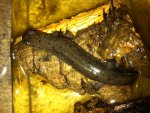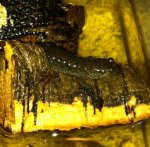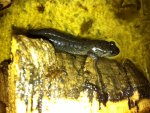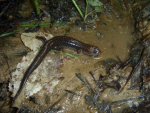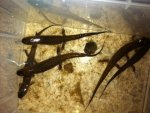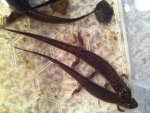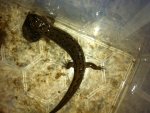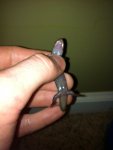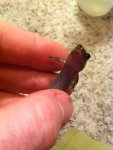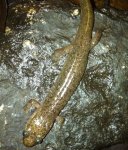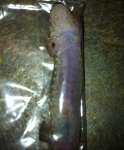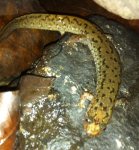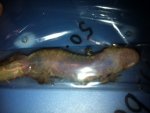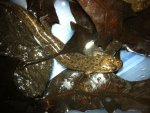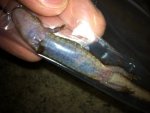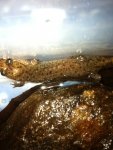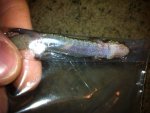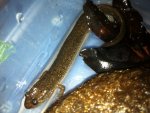-
Did you know that registered users see fewer ads? Register today!
You are using an out of date browser. It may not display this or other websites correctly.
You should upgrade or use an alternative browser.
You should upgrade or use an alternative browser.
Desmognathus ID
- Thread starter JMH
- Start date
- Joined
- Oct 14, 2004
- Messages
- 3,259
- Reaction score
- 63
- Points
- 48
- Location
- Bristol
- Country
- United Kingdom
Given that many Desmognathus species look very similar I think it's going to be very difficult to get a firm ID from such dark photos. Did location play a part in narrowing down to those two? Why not D. conanti for example? Out of the two species you've suggested it looks more like D. auriculatus but mainly because it lacks the distinctive lichen markings of D. monticola. To add further confusion D. auriculatus hybridizes with D. conanti.
JMH
Member
- Joined
- May 28, 2011
- Messages
- 71
- Reaction score
- 4
- Points
- 8
- Location
- Illinois
- Country
- United States
- Display Name
- JMH
I'm pretty sure it is D. auriculatus, it doesnt have the dorsal pairs of spots found on D. monticola and D. conanti. This one has a line of light colored dots running down both sides, most often found on D. auriculatus. I also took some better pictures.
Attachments
Vern5384
New member
- Joined
- Nov 30, 2012
- Messages
- 35
- Reaction score
- 1
- Points
- 0
- Location
- Georgia, USA
- Country
- United States
Auriculatus is only found in the Coastal Plain, and this doesn't look like any that I've seen. If it came from the Piedmont, then it is probably conanti or possibly monticola, although I'm leaning towards the former. Locality info can really help narrow things down more. Where exactly was it found?
Vern5384
New member
- Joined
- Nov 30, 2012
- Messages
- 35
- Reaction score
- 1
- Points
- 0
- Location
- Georgia, USA
- Country
- United States
Photos of the belly would help, as well.
Aneides
New member
- Joined
- Feb 3, 2011
- Messages
- 87
- Reaction score
- 1
- Points
- 0
- Country
- United States
I'm pretty sure it is D. auriculatus, it doesnt have the dorsal pairs of spots found on D. monticola and D. conanti. This one has a line of light colored dots running down both sides, most often found on D. auriculatus. I also took some better pictures.
I agree with you on that identification.
Aneides
jaster
New member
- Joined
- Oct 25, 2009
- Messages
- 137
- Reaction score
- 3
- Points
- 0
- Location
- Boone, North Carolina
- Country
- United States
I don't think it can be D. auriculatus, it is too far north. Either D. monticola or D. conanti. An easy way to tell between D. monticola and the D. fuscus group are the toes. D. monticola (and the other large duskies) will have black tips while D. conanti and the others do not. A bit hard to tell from the photo, but I would lean toward D. conanti. Both species do occur in you county though.
-Brad
-Brad
Vern5384
New member
- Joined
- Nov 30, 2012
- Messages
- 35
- Reaction score
- 1
- Points
- 0
- Location
- Georgia, USA
- Country
- United States
It would be an exceptional find and an incredible range extension if it were auriculatus, however, it doesn't look like auriculatus to me. Auriculatus are found in the margins of blackwater streams, sphagnum bogs, and cypress swamps in the Coastal Plain. Alpharetta is north of Atl, far into the Piedmont (actually closer to the Appalachians), very far from this range and habitat. The most parsimonious conclusion would be conanti, although monticola also can be found is this part of the state and the dorsal marking on this animal resemble monticola I have found in north GA and western NC, as does the description of the single row of white spots on the side. This is why I asked for pics of the venter. Monticola has a solid colored pale venter fairly distinctly separated from the dorsal color on the sides.
Lamb
New member
- Joined
- Feb 28, 2009
- Messages
- 222
- Reaction score
- 12
- Points
- 0
- Age
- 36
- Location
- USA
- Country
- United States
Although the majority of transformed D. conanti that I have seen in my area (South Mississippi) have the characteristic bright dorsal spots, I do find larger, older individuals that have a bland pattern of scattered dots or flecks, like the individual in the photo I have attached. The pattern seems somewhat similar to that of your individual. A recent, helpful paper in terms of distinguishing between conanti and auriculatus is that of Graham et al. (2010):
Graham et al. 2010. Status and possible decline of the southern dusky salamander (Desmognathus auriculatus in Georgia and Alabama, USA. Herpetological Conservation and BIology 5(3):360-373.
Graham et al. mention that conanti can have small, light flecks along their sides that could be confused with the "portholes" of auriculatus. So if everyone isn't consistent in what they are calling a porthole, using that trait could lead to misidentifications. In the paper, they say that the number of costal grooves between adpressed limbs is a good character to distinguish these two species, auriculatus having 4-6, and conanti having 3 or fewer. Also, as others here have mentioned, Graham et al. emphasize that the species likely segregate or adhere to certain habitat types, conanti being more of a ravine dweller, and auriculatus more of a mucky, swamp dweller. I managed to speak with Graham about this, and he mentioned that if the water is seep fed, the populations at that water source would more likely be conanti, at least for this part of the Coastal Plain.
Graham et al. 2010. Status and possible decline of the southern dusky salamander (Desmognathus auriculatus in Georgia and Alabama, USA. Herpetological Conservation and BIology 5(3):360-373.
Graham et al. mention that conanti can have small, light flecks along their sides that could be confused with the "portholes" of auriculatus. So if everyone isn't consistent in what they are calling a porthole, using that trait could lead to misidentifications. In the paper, they say that the number of costal grooves between adpressed limbs is a good character to distinguish these two species, auriculatus having 4-6, and conanti having 3 or fewer. Also, as others here have mentioned, Graham et al. emphasize that the species likely segregate or adhere to certain habitat types, conanti being more of a ravine dweller, and auriculatus more of a mucky, swamp dweller. I managed to speak with Graham about this, and he mentioned that if the water is seep fed, the populations at that water source would more likely be conanti, at least for this part of the Coastal Plain.
Attachments
Last edited:
JMH
Member
- Joined
- May 28, 2011
- Messages
- 71
- Reaction score
- 4
- Points
- 8
- Location
- Illinois
- Country
- United States
- Display Name
- JMH
After doing a bit more research and reading the last posts by Lamb and Mark, I agree with it being D. conanti. On Sunday I went and got 5 more, all found within a few feet of each other. One of them looks quite different than the rest. I took some pictures of the new group, the strange individual, and ventral shots.
Attachments
jaster
New member
- Joined
- Oct 25, 2009
- Messages
- 137
- Reaction score
- 3
- Points
- 0
- Location
- Boone, North Carolina
- Country
- United States
The large on in the second photo does remind me of D. monticola. They are bigger than the fuscus groups, and markings on its back are monticola-esque. Which ones did you take the body shots of? I know those are a pain to do, manders dont like being flipped. Maybe try using a ziploc bag in the future to pin em down and get a great shot. Both of those individuals seem to have a uniformly gray belly in my eyes. That points to D. monticola. D. conanti will have a more mottled pattern underneath. Still couldn't see the toes well.
Todd Pierson
New member
- Joined
- Jul 31, 2009
- Messages
- 26
- Reaction score
- 6
- Points
- 3
- Country
- United States
Yeah, which individuals are the ventral shots from? The pattern and tail shape on some of those individuals is reminiscent of D. monticola, but they should have a very light, unmarked belly like this:
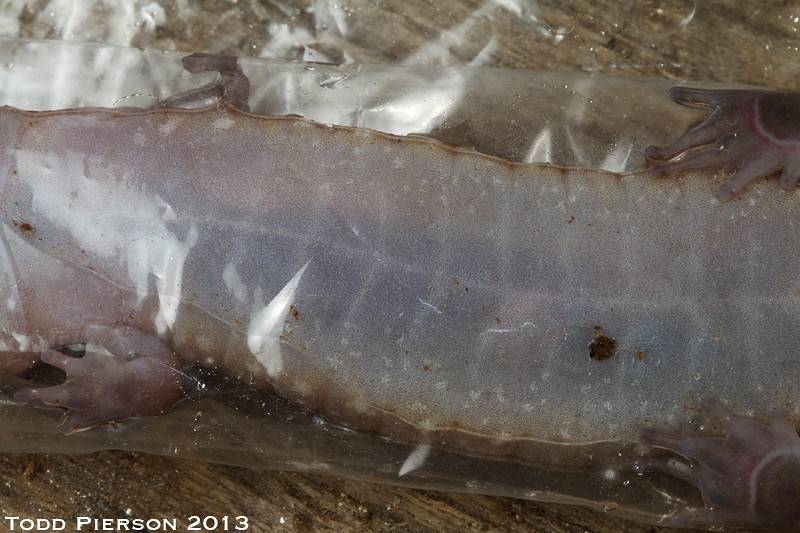
And here is a typical D. conanti belly.
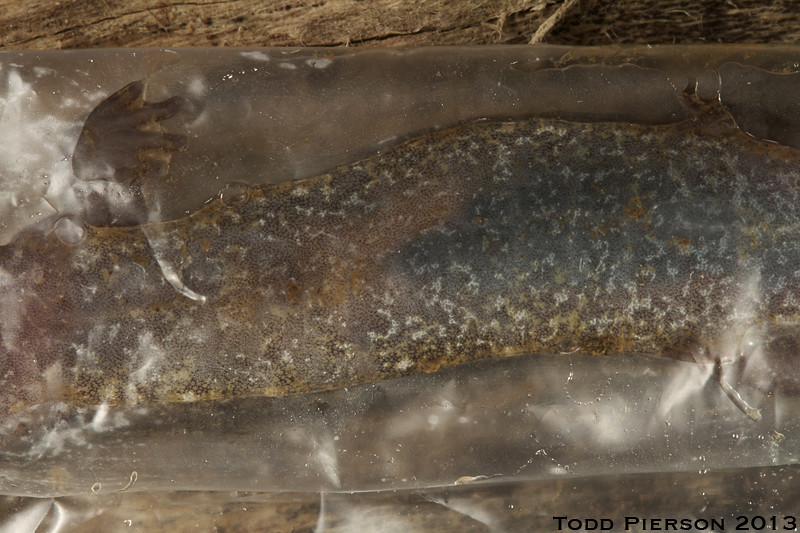
These two salamanders can be pretty difficult to distinguish in northern Georgia.

And here is a typical D. conanti belly.

These two salamanders can be pretty difficult to distinguish in northern Georgia.
JMH
Member
- Joined
- May 28, 2011
- Messages
- 71
- Reaction score
- 4
- Points
- 8
- Location
- Illinois
- Country
- United States
- Display Name
- JMH
I have been really busy with school but I finally had a chance to get some pictures last night. The pictures should be labled, D. 1A, D. 1B, D. 2A... There is one ventral and dorsal shot for each of the six salamanders.
Attachments
Vern5384
New member
- Joined
- Nov 30, 2012
- Messages
- 35
- Reaction score
- 1
- Points
- 0
- Location
- Georgia, USA
- Country
- United States
Definitely monticola.
FrogEyes
Active member
- Joined
- Sep 5, 2010
- Messages
- 906
- Reaction score
- 46
- Points
- 28
- Location
- Southern Minnesota
- Country
- Canada
It's worth noting that several well-known "species" are species complexes [eg. D.ocoee, D.auriculatus, D.quadramaculatus, D.marmoratus, possibly D.conanti, possibly D.fuscus], and there are nearly twice as many species known as are named. In many cases, that means that even a "solid" ID only has a 50% chance of being right. Locality and a small stack of scientific papers is about the only way to get something bordering on reliable.
Todd Pierson
New member
- Joined
- Jul 31, 2009
- Messages
- 26
- Reaction score
- 6
- Points
- 3
- Country
- United States
Yeah, I'd go with D. monticola. There's certainly something weird going on with that species, though.
General chit-chat
- No one is chatting at the moment.



